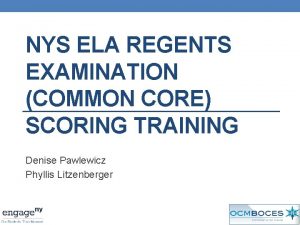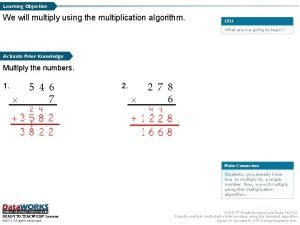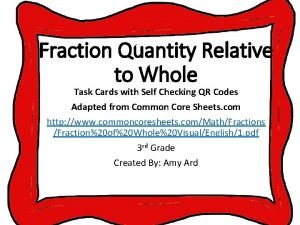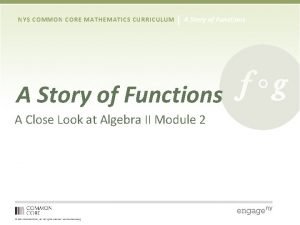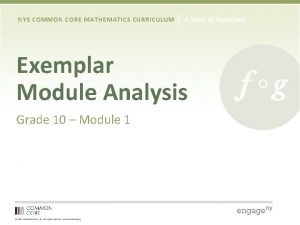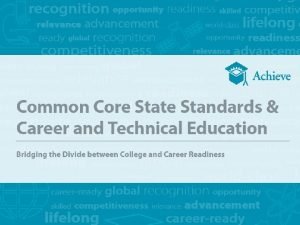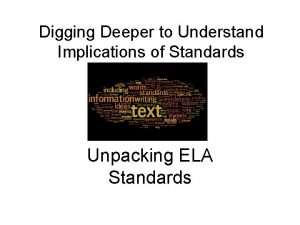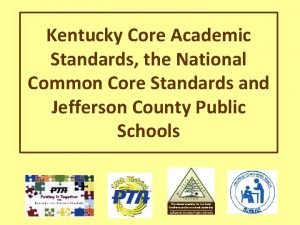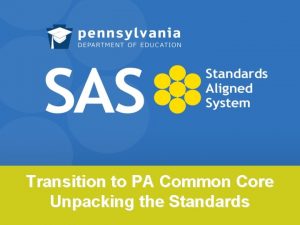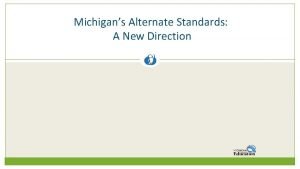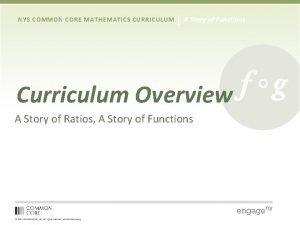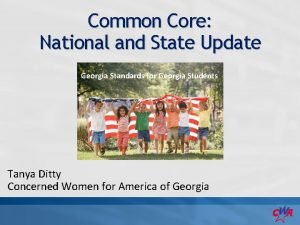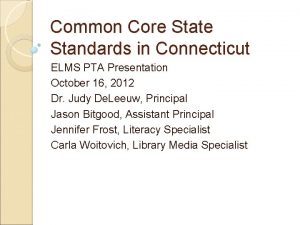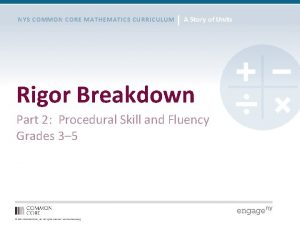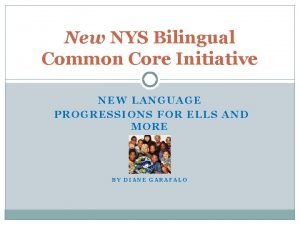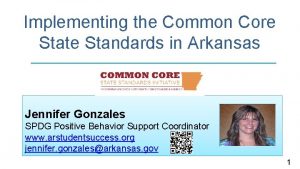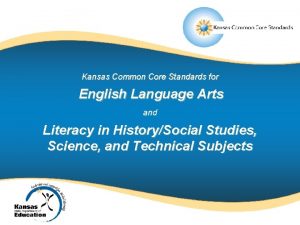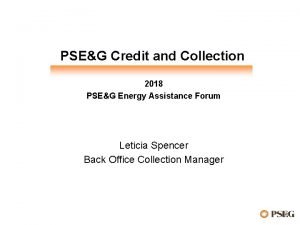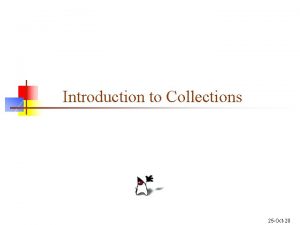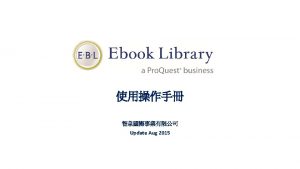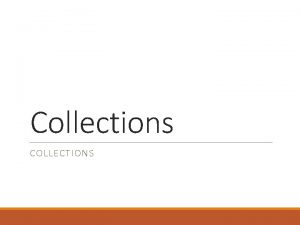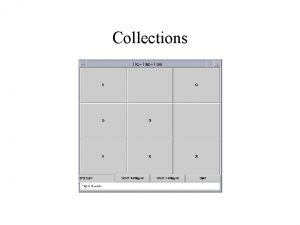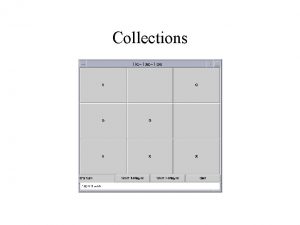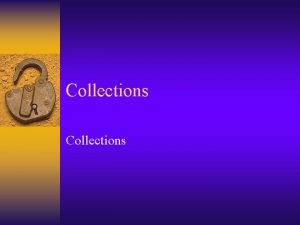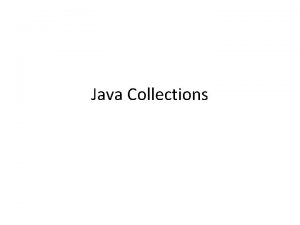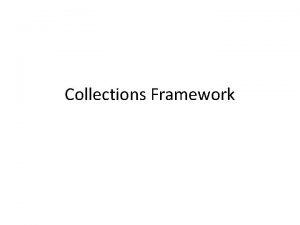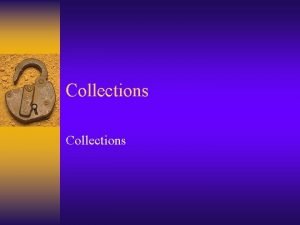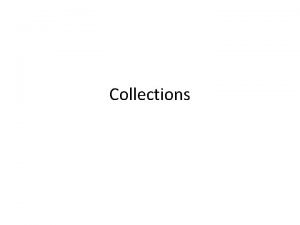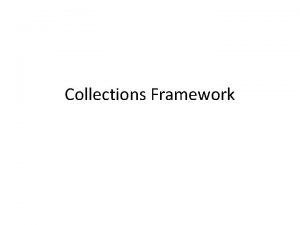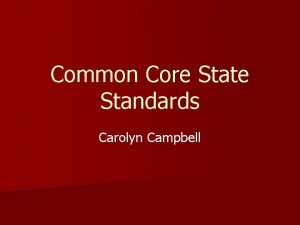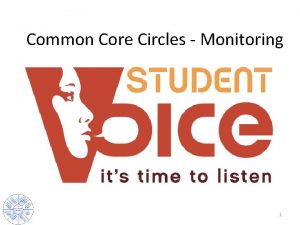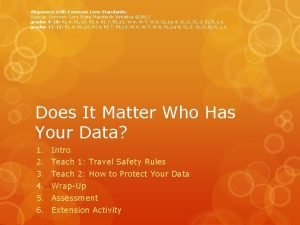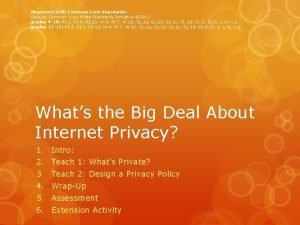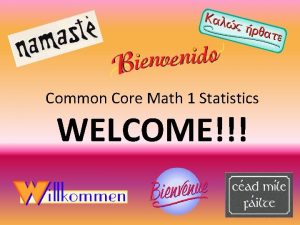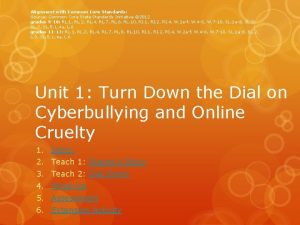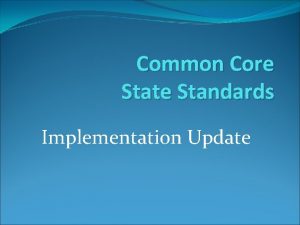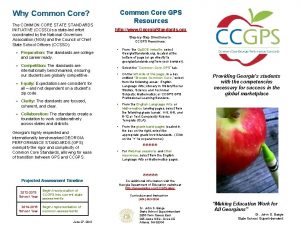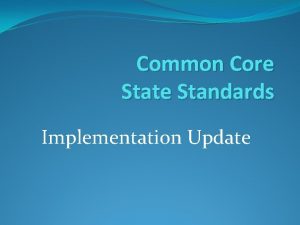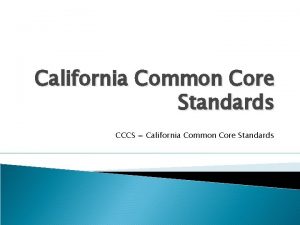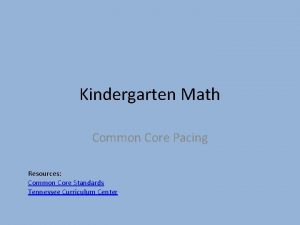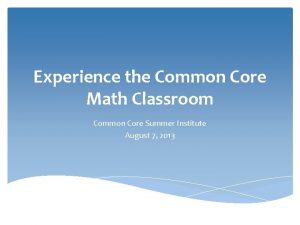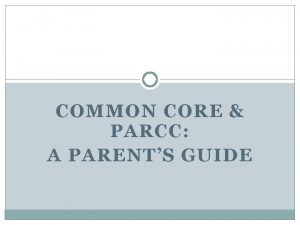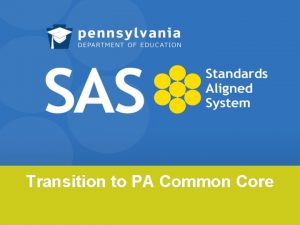COMMON CORE COLLECTIONS Understand Respond Understand What are
































- Slides: 32

COMMON CORE & COLLECTIONS: Understand & Respond

Understand What are the Common Core State Standards? What changes does Common Core bring?

Common Core State Standards are …shared content standards for English language arts, literacy in the content areas, & math …designed to help ensure that all students are college and career ready in literacy and mathematics no later than the end of high school …meant to describe what students in our nation should know and be able to do …adopted by 43 states (+/-) …often referred to as Common Core, CC, or CCSS http: //www. ode. state. or. us/wma/teachlearn/commoncore/common-core-fact-sheet. pdf

Put another way, CCSS …represent a coherent progression of learning expectations in English language arts and math …are designed to prepare K 12 students for college and career success …define knowledge & skills students should have …describe end-of-year expectations …provide consistency in expectations among states …emphasize rigor and critical thinking http: //educationnorthwest. org/webfm_send/1158 (very helpful organizational overview) html http: //www. ccsso. org/Resources/Digital_Resources/Common_Core_Implementation_Video_Series. http: //www. corestandards. org/ELA-Literacy/introduction/key-design-consideration

ODE Common Core Homepage http: //www. ode. state. or. us/search/page/? id=2860 Start here to learn more about Common Core in Oregon Resources for various audiences Toolkits

ODE Resources for CCSS in ELA Standards for English language arts (ELA) & literacy in history/social studies, science, and technical subjects http: //www. ode. state. or. us/search/page/? id=3359 http: //www. ode. state. or. us/teachlearn/real/newspaper_section. aspx? subjectcd=CCSSE Standards by grade level or grade groupings Info on text complexity & text exemplars Additional resources Note: literacy in content areas standards supplement existing standards for history/ social studies, science, and technology

ODE Tools to Manipulate Standards by Design http: //www. ode. state. or. us/teachlearn/real/standards/ Select one or multiple subjects Can choose to include support materials Generate an Excel spreadsheet or printable PDF Searchable Standards Search http: //www. ode. state. or. us/teachlearn/real/standards/searchablestandards. aspx by keyword within a subject & grade For all Oregon education standards, not just CCSS

Comparison of ELA Standards for 4 th, 8 th, & 12 th Grades Reading Anchor Standard 1: Read closely to determine what the text says explicitly and to make logical inferences from it; cite specific textual evidence when writing or speaking to support conclusions drawn from the text. Note: Anchor standards are the same across all grades. Note about grade-level reading standards: RL = literature RI = informational text RF = foundational skills

Comparison of ELA Standards for 4 th, 8 th, & 12 th Grades (continued) Grade-level specific standards related to Reading Anchor Standard 1 4. RI. 1 Refer to details and examples in a text when explaining what the text says explicitly and when drawing inferences from the text. 8. RI. 1 Cite the textual evidence that most strongly supports an analysis of what the text says explicitly as well as inferences drawn from the text. 11 -12. RI. 1 Cite strong and thorough textual evidence to support analysis of what the text says explicitly as well as inferences drawn from the text, including determining where the text leaves matters uncertain.

Comparison of ELA Standards for 4 th, 8 th, & 12 th Grades (continued) Writing Anchor Standard 8: Gather relevant information from multiple print and digital sources, assess the credibility and accuracy of each source, and integrate the information while avoiding plagiarism. Note: ELA standards are divided into 4 areas: reading, writing, speaking & listening, and language.

Comparison of ELA Standards for 4 th, 8 th, & 12 th Grades (continued) Grade-level specific standards related to Writing Anchor Standard 8 4. W. 8 Recall relevant information from experiences or gather relevant information from print and digital sources; take notes and categorize information, and provide a list of sources. 8. W. 8 Gather relevant information from multiple print and digital sources, using search terms effectively; assess the credibility and accuracy of each source; and quote or paraphrase the data and conclusions of others while avoiding plagiarism and following a standard format for citation. 11 -12. W. 8 Gather relevant information from multiple authoritative print and digital sources, using advanced searches effectively; assess the strengths and limitations of each source in terms of the task, purpose, and audience; integrate information into the text selectively to maintain the flow of ideas, avoiding plagiarism and overreliance on any one source and following a standard format for citation.

Six Shifts for ELA & Literacy Informational Text is a Subset of Nonfiction

Six Shifts for ELA & Literacy Levels of meaning or purpose, structure, language conventionality and clarity, and knowledge demands Word length or frequency, sentence length, and text cohesion (R) motivation, knowledge, and experiences (T) purpose and complexity; questions posed

Six Shifts for ELA & Literacy

Six Shifts for ELA & Literacy http: //www. ode. state. or. us/wma/teachlearn/commoncore/common-core-shifts-ela. pdf

Informational Text vs. Literary Nonfiction http: //www. ode. state. or. us/teachlearn/subjects/elarts/reading/literacy/have-youever. pdf (p. R 7) First, informational text is a broad category that includes the subgenres of exposition, argument, and functional text. Informational text comes in many different forms, including books, magazines, handouts, brochures, CDROMs, journal articles, technical texts (directions, forms, and information displayed in graphs, charts, or maps), and Internet resources, and it focuses on many different topics, including those related to history, social studies, science, arts, and technical subjects.

Informational Text vs. Literary Nonfiction Second, the CCSS include literary nonfiction as a type of informational text and include autobiographies, memoirs, personal essays, speeches, opinion pieces, essays about art or literature, journalism, and historical, scientific, technical, or economic accounts (including digital sources) written for a broad audience. It is distinguished by literary techniques and artistic vision.

Informational Text vs. Literary Nonfiction Third, it’s important to note that while much of literary nonfiction follows a narrative text structure, at grades 6 -12 the Standards emphasize arguments (such as those in the Founding Documents) and other literary nonfiction that is built on informational text structures rather than narrative literary nonfiction that are structured as stories (such as memoirs or biographies). See chart on pages R 10 & R 11

Respond How can public library collections and programming support schools as they work with CCSS?

Quality Nonfiction in Light of Specific Common Core Standards Much informational text = nonfiction, including some narrative but also argument If X is a quality book by “library standards, " which Common Core standard might it also support? Examples from SLJ article, “ 20 Outstanding Nonfiction Books: Core Essentials” http: //www. slj. com/2013/05/standards/common-core/20 -outstanding-nonfiction-books-core-essentials/#_

Emphasize Non-Book Informational Text, Too Help folks connect periodicals databases with informational text & literary nonfiction Gale & other per. databases have articles from quality magazines, journals, newspapers, & reference books They also have historical documents like primary sources, letters, diary entries, and political cartoons Use advanced search to limit by document type Help patrons set up journal alerts to get content in inbox “Balancing Fiction and Nonfiction’ (blog posting) http: //greecesecondaryela. wordpress. com/2012/03/25/balancing-fiction-and-nonfiction/ Or. K 12 Literacy Framework, Reading (“K-5: Foundations” & “K-12 Comprehension): http: //www. ode. state. or. us/search/page/? id=3519 Which K 12 Database Do I Use When? (scroll to very bottom of page): http: //secondary. educator. oslis. org/find-information

Emphasize Non-Book Informational Text, Too Emphasize the informational text available in online encyclopedias like World Book & Grolier, esp. those to which your library subscribes Emphasize magazines available in Zinio or similar products Point to free, quality informational text online Library of Congress, National Archives for founding documents Newsela. com for current events articles in 5 Lexiles

Informational Text & Lexile Ranges Emphasis on reading increasingly complex text = greater need to identify reading level or difficulty level of text Popular system in use is Lexile Framework www. lexile. com Students are assigned a Lexile reader measure after taking a reading test (ex: 880 L) Oregon students receive Lexile score from reading portion of Oregon’s current statewide test

Informational Text & Lexile Ranges Books, articles, and text can be analyzed by Meta. Metrics and assigned a Lexile measure Can search for book’s Lexile rating Bark, George = 130 L vs. Jumanji = 620 L Tuck Everlasting = 770 L vs. Diary of a Wimpy Kid = 1060 L The Scarlet Letter = 1420 L vs. Lincoln (Freedman) = 1110 L Goal: “If we know how well a student can read and how hard a specific book is to comprehend, we can predict how well that student will likely understand the book. ” http: //lexile. com/about-lexile/lexile-overview/

Informational Text & Lexile Ranges To support teachers’ need to scaffold instruction and to immerse students in complex text, need multiple reading levels on same topic. High school study of Civil War would still benefit from quality books aimed at junior high, for example

Informational Text & Lexile Ranges Caution not to overemphasize Lexiles Lifelong reader = self-selector of materials, subject matter, format, & purpose of reading Educators => Do they make sure that not all student reading is assigned or restricted to Lexile ranges? School library staff => Do checkout limits accommodate both assigned and self-selected reading? Even Lexile reps recognize that the scoring system is not perfect and is a starting point & not the final word http: //lexile. com/about-lexile/lexile-overview/ http: //www. lexile. com/tools/lexile-map/

Support Growth in Writing Quality books and texts serve as examples for writing development, too. (Think of CCSS shifts 4 & 5. ) Promote grammar, vocabulary, & writing e-books and courses in Learning. Express Library Promote ability to receive detailed assistance from Tutor. com (if have access) & others *LEL & Tutor. com support math rigors, too

Subject Guides & Booklists Think of subject guides or pathfinders in a new light Want one called Common Core Resources for your Middle Schooler, for ex. ? Could include CCSS tips for parents PTA two-pagers, PTA four-pagers, & Roadmaps, ELA Booklists Serve as text set ideas for teachers Ones dedicated to nonfiction (Zinio magazines for high schoolers)

Programming How does your teen programming incorporate or focus on informational text? Could you hold Mock Seibert events? Can your book displays pair fiction and nonfiction? Can you have a booktalk visit dedicated to NF? Can you have a NF book club? How might your teen advisory board help?

Get Input from Educators Schools & educators = in various places along needs continuum Ask! => What do you need/want from our staff and our collection when it comes to Common Core? Make connection via school library staff Attend ELA department meeting (or other subjects) Seek invitation to a school/district inservice about CC to learn what they are learning Create short survey to gather feedback from teachers Offer training (reflect on results, modify, repeat)

What Ideas Do You Have?

Questions? Please ask! Jennifer Maurer School Library Consultant Oregon State Library 503. 378. 5011 jennifer. maurer@state. or. us Presentation at OYAN Fall Workshop October 24, 2014
 Insidan region jh
Insidan region jh To understand recursion you must understand recursion
To understand recursion you must understand recursion Core capabilities and core rigidities
Core capabilities and core rigidities Inner core and outer core
Inner core and outer core Earth crust thickness
Earth crust thickness Which layer is the least dense
Which layer is the least dense Common core ela assessments
Common core ela assessments English regents part 3 text analysis response
English regents part 3 text analysis response Common core lattice multiplication
Common core lattice multiplication Fraction quantity relative to whole
Fraction quantity relative to whole Lesson 4 from circle-ometry to trigonometry
Lesson 4 from circle-ometry to trigonometry Utah common core math
Utah common core math Nys common core math
Nys common core math Common career technical core standards
Common career technical core standards Common core state standards missouri
Common core state standards missouri Unpacking common core standards template
Unpacking common core standards template Common core standards ky
Common core standards ky Common core state standards pa
Common core state standards pa 4th grade math jeopardy common core
4th grade math jeopardy common core Essential elements michigan
Essential elements michigan Nys common core mathematics curriculum
Nys common core mathematics curriculum Common core standards ga
Common core standards ga Connecticut common core state standards
Connecticut common core state standards Nys common core mathematics curriculum
Nys common core mathematics curriculum Essential elements standards
Essential elements standards Bilingual common core progressions
Bilingual common core progressions Common core standards arkansas
Common core standards arkansas Common core reading
Common core reading Formative assessment cycle
Formative assessment cycle What are neuron processes
What are neuron processes Pseg credit and collections
Pseg credit and collections Collections
Collections Sruthika collections
Sruthika collections







